Top News

October 14, 2016 Ryukyu Shimpo
By Masatoshi Inafuku
On October 8, nine people from Okinawa established the “India Okinawa Kenjinkai” in India, where there was previously kenjinkai group. At “the First India Okinawa Kenjinkai,” which was held in Gurgaon, near Delhi, the Kenjinkai members pledged to embody Uchinanchu spirits of “Ichariba chode,” “Yuimaru,” and “Bankoku shinryo” and to promote and preserve Okinawan culture in India.
Momoyo Nakazato from Urasoe City, who is a teacher, was appointed as president. Members include Yasushi Shinzato, who is also a teacher, and his family members Isono, Koharu, and Etsu from Naha City, Yumeno Higa from Kitanakagusuku, who works at a government organization, Kanefumi Kina from Naha City, who works in manufacturing, Naoki Fukuda from Nagasaki Prefecture, who lived in Miyakojima City for two years, and Ayako Ueno from Kagoshima Prefecture, who has a brother living in Okinawa.
In India, where Japanese business has been successful, other prefectures have set up kenjinkai and have been actively engaged in group activities. When Nakazato was thinking of setting up an Okinawa kenjinkai, she connected with Kina, who will participate in the Sixth Worldwide Uchinanchu Festival from India, and made contacts with Okinawans dotted around India.
At the first kenjinkai, members played and sang “Asatoya yunta” and “Shimanchu nu takara” with sanshin. Members shared their feelings about Okinawa, with one of them saying, “My children listen to BEGIN’s songs every day and cry.” Another member said, “I am re-learning Okinawan culture again after moving to India.”
President Nakazato said, “We live far away, but there is no difference in the feeling of loving Okinawa. In India, which is not a convenient place to live, mutual help and connection are important. Keeping ‘Ichariba chode’ in mind, I hope to improve life in India with the kenjinkai members.”
The kenjinkai will march in a parade at the pre-event for the Worldwide Uchinanchu Festival on the 26th with Indians in Okinawa and people who have connections with India. Kina, who wanted to participate in the festival, will perform a traditional Indian prayer ceremony, “Puja”, at the parade. He said, “I would like to pray for the peace and prosperity of Okinawa, India, and the world.”
(English translation by T&CT and Megumi Chibana)
Go to Japanese
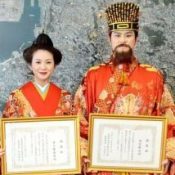
October 12, 2016 Ryukyu Shimpo
A ceremony for certification of the king and queen of the Shurijo Festival was held on October 11 at the Naha City Office. The festival is sponsored by the Shurijo Festival Planning Committee and co-sponsored by the Ryukyu Shimpo and Shuri Promotion Association. The chair of the committee, the Naha City Mayor Mikiko Shiroma, handed certificates to 35-year old Hiroshi Nakasone and 30-year old Masami Guishiken for king and queen respectively.
The king and queen were selected through an audition held at the Okinawa Miyako Hotel on September 18. There were 26 applicants for the king’s seat and 34 applicants for the queen’s seat.
Nakasone, who supervises a third-grade class at the Tomari Elementary School, said, “I want to share with my students what I experience at the various events.” Gushiken shared her excitement, saying, “I want to contribute to promoting Okinawa.”
The Shurijo Festival will be held from October 28 to November 3. There will be a Sappo march and ceremony at the Shurijo Castle Park on October 29, a Ryukyu Kingdom march at Kokusai Dori on October 30, and a traditional ceremony at the Shurijo Castle Park on November 3.
(English translation by T&CT and Sayaka Sakuma)
Go to Japanese
October 14, 2016 Ryukyu Shimpo
Swimming was prohibited in Chatan beaches after the sighting of a shark, reportedly a Bull shark, in the Mihama area of the Town. Since October 12, swimming in Tropical beach in the Mashiki area of Ginowan City has also been prohibited. This is the third beach to have swimming banned, after Sunset Beach and Araha Beach in Chatan.
After the Chatan Town fisheries cooperative started preparing to hunt the shark, Ginowan City prohibited swimming in the city for fear of the shark fleeing to beaches around the city. Depending on how the shark hunt goes, the municipalities will determine when to resume allowing people to swim. As of October 13, there were no reports of shark sightings to the managers of Tropical Beach
(English translation by T&CT)
Go to Japanese

October 10, 2016 Ryukyu Shimpo
Japanese immigrants who took root in Argentina over 100 years ago were celebrated at the Teatro Greison in Monte Grande, located in the southern suburbs of Greater Buenos Aires on August 7. The tribute was planned by Dr. Roberto Agarie (doctor or forensic medicine and private ambassador to Okinawa), ex-president of La Plata Hochi, and had the theme of “A celebration of immigrant pioneers from the Agarie family.”
The immigrants, who mainly originated from Nago, Okinawa, had specialized skills and qualifications to be things such as veterinarians, ranchers and civil architects. As explained by Mr. Agarie, these highly-skilled immigrants allowed those who came after them, particularly in the southern suburbs of Greater Buenos Aires, to integrate into society. Through their leadership and support, the immigrants who came after, including the Agarie family, found success in various fields, and contributed to society for many years.
These pioneers, who mainly labored at the industrialization of agriculture included Kurajiro Ishikawa, Hugo Yoshida, Wachi Nakaya, Koro Nakandakare, Seiko Nakandakare, Nakasuke Nakaganeku, and Ryoji Okada.
In addition to the many descendants of those being honored, Dr. Antonio Simon Agarie; Dr. Marcelo Agarie, Buenos Aires 18th public hospital director; Julio E. Agarie, chairman of the Northern Buenos Aires Pharmacists Association; Yasunobu Oshiro, Nago City civic hall director; Kazuyoshi Bunno, president of the Argentinian Colonial Society; Kazuyuki Yoshimura from the Japanese embassy in Argentina; and Juan Sarrafian, chairman of the Argentinian Immigrant Association; were also in attendance.
(English translation by TC&T and Sam Grieb)
Go to Japanese
October 5, 2016 Ryukyu Shimpo
There are 34 cases in which U.S. military personnel were charged for violating the Japanese criminal code in Okinawa. The figures accounted for 45 percent of 76 cases nationwide. On October 4, Kiichiro Jahana, the head of the Executive Office of the Governor, announced the number to Okinawa Prefectural assembly member Masatsugu Uehara in an inquiry session.
A working team, in which representatives from governments of Japan, Okinawa, and the U.S. military in Okinawa discuss preventive measures against crimes and incidents involving the U.S. military personnel, announced in April that there were 34 cases of recorded crimes involving 42 servicemen in Okinawa. The figures had increased by five cases and 15 people.
(English translation by T&CT)
Go to Japanese
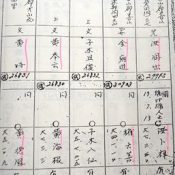
October 6, 2016 Ryukyu Shimpo
The family of two Korean war victims who were suspected to have died in Okinawa had been hoping to get the victims’ names inscribed on the Cornerstone of Peace in Mabuni, Itoman City. However, on October 5, they were told they could not apply because there was no official record to prove the victims died in Okinawa. A representative of “Okinawa han no hi no kai,” an organization that helps war victim families with procedures to get names inscribed, said, “To reveal the truth of Korean war victims dying in Okinawa, we hope to have flexible enforcement of inscription rules for Koreans.”
The two victims are Quan Un-son and Pak Hui-te. According to the enlistment record stored by the Ministry of Health, Labour and Welfare, both were assigned to the Special Surface Force 104 Squadron under the direct control of the 32nd Army. The squadron formation chart also shows that Quan was assigned to the 3rd Platoon on Okinawa Island, and Pak belonged to the 1st Platoon on Tokashiki Island.
According to Tokiko Okamoto of “Okinawa Han no hi no kai,” Su-chon, the son of Quan Un-son, heard a testimony about Un-son’s death from survivors of the Battle of Okinawa. He was told his father sought shelter in a cave that was later bombed.” Chuna, the daughter of Pak, also heard that Pak was decapitated by a Japanese soldier because “he stole and ate a potato from a civilian residence.”
However, the official record in the Korean family registry only says “missing” and “death” on the Korean family registry.
On September 23, “Okinawa Han no hi no kai” submitted a petition requesting research on Korean victims of the Battle of Okinawa and inscription of the two names. The September Education and Welfare Committee Regular Meeting deliberated on the petition on October 6. Okimoto said, “The Japanese government does not carry out research, so most Korean victims are recorded ‘missing.’ To convey a precise picture of the Battle of Okinawa to the next generation and to follow the principle of the Cornerstone of Peace, inscription rules for Korean victims should be as flexible as for Okinawans.”
As for Korean victims, more than 10,000 victims are enshrined at the Korean War Memorial in Peace Memorial Park. Meanwhile, the number of inscribed names on the Cornerstone of Peace is 447, which includes North and South Koreans. Inscription of Korean war victims is an ongoing issue for the Cornerstone of Peace.
(English translation by T&CT and Megumi Chibana)
Go to Japanese
October 5, 2016 Ryukyu Shimpo
On October 4, it was discovered that the Ministry of Defense (MOD) has a plan to conduct joint use of the U.S. military’s Northern Training Area as a training area for the Japan Self-Defense Forces (SDF) to engage in anti-guerilla warfare training. The information was revealed at a hearing before the Okinawa Prefectural Assembly in response to a question by Assemblyman Osamu Toguchi of the Japan Communist Party, who posed his question on the basis of a 2012 internal MOD document titled “Regarding dynamic defense cooperation between Japan and the United States.” Vice Governor Mitsuo Ageda expressed opposition to the increase in burden borne by Okinawans in conjunction with joint use, saying, “The government is always saying that it will reduce the base burden on Okinawa. Whether it’s the U.S. military or the Self-Defense Forces, the base burden on Okinawans cannot be increased.”
The Japanese government asserts that building new helicopter landing pads (helipads) will enable the return of more than half of the Northern Training Area, thus entailing a reduction of the base burden on Okinawa. However, joint use by the SDF as an anti-guerilla warfare training area raises the concern of yet another base-related burden being placed on Okinawa.
Plans have also been revealed that involve permanent joint use by the SDF of U.S. military facilities in the northern part of Okinawa Island, such as Camp Schwab and Camp Hansen. With the most recent revelation of planned joint use of the Northern Training Area, it appears that the SDF and the U.S. military troops in Okinawa are becoming integrated.
Assemblyman Toguchi was critical, saying, “Even the SDF are being concentrated in Okinawa. Not only is this not a reduction of burden, it is in fact a reinforcement of burden.”
With respect to the Northern Training Area, in his policy speech on September 26, Prime Minister Shinzo Abe asserted that the return of land in conjunction with the new helipad construction would lead to a reduction of burden borne by Okinawa, emphasizing that “roughly 20% of land used for U.S. military facilities in Okinawa will be returned, the largest land return since Okinawa was restored to Japanese administration.”
(English translation by T&CT and Sandi Aritza)
Go to Japanese
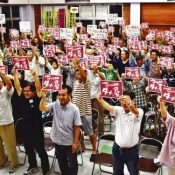
September 30, 2016 Ryukyu Shimpo
Regarding the debate over deployment of the Japan Ground Self-Defense Force (JGSDF) to Ishigaki City, a rally march and citizens’ gathering were held on September 29 in protest of the city assembly’s passing of a resolution to request the deployment.
Approximately 200 citizens attended the event, which labeled the decision by the city assembly an autocratic action. The group also passed a protest resolution at the meeting.
The participants departed from the Okawa community center and continued the protest walk through the city, passing the city office, for three kilometers. The protestors chanted together, saying they won’t let the city assembly dictate, and that the mayor and the assembly must respect the voice of its citizens.
The group later held a meeting at the Okinawa community center, where residents living near the planned deployment location in Hirae Omata shared their concerns. The residents appealed to their leaders, saying (about the resolution) they were deeply upset by the resolution, and that it was forcibly carried out without clarifying the detail about the deployment sites and the number of troops. They said local residents must stop the deployment plan because it would degrade their peaceful life.
At the meeting, members of the group pointed out that the current city assembly members were not voted in on a stance supporting the deployment of JGSDF in Ishigaki. They said they felt a strong distrust and frustration in response to the way the assembly forcibly made the decision without adequate discussion.’
(English translation by T&CT and Sayaka Sakuma)
Go to Japanese
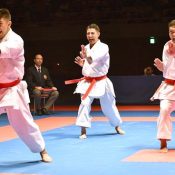
October 3, 2016 Ryukyu Shimpo
The World Karate 1 Premier League was held on October 2 at the Okinawa Prefectural Budokan in Naha City. The Japanese team, including Arata Kinjo, Ryo Kyuna and Takuya Uemura, who belong to Ryueiryu and the National team, won three consecutive championship titles and achieved five career titles in the men’s Kata team division. Kyuna also won the title in the men’s Kata division.
The World Karate 1 Premier League was hosted by the World Karate Federation (WKF) and Okinawa Prefectural Government.
(English translation by T&CT)
Go to Japanese
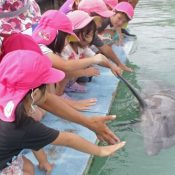
October 2, 2016 Ryukyu Shimpo
[Motobu]
The male bottlenose dolphin, Sun, celebrated his first birthday on September 26 at Motobu Genki Village in Motohama, Motobu. He celebrated with the class of two- to four-year-olds from Hikari Preschool, who sang “Happy Birthday” and fed the dolphin fish as a present. Sun’s mother, Sugar, and her friend, Palm, also celebrated with some synchronized jumping.
Breeding is difficult with bottlenose dolphins. With the help of his caretakers, Sun will be the first bottlenose dolphin to reach its first birthday.
Toshimitsu Kobayashi, head of the Okinawa Marine Research Center (OMCR), which debuted the dolphin petting at Motobu Genki Village, said, “We wanted him to shine like the sun, so we gave him the name ‘Sun.’ We hope to increase the size of his family.”
Nayu Miyagi, 3, said that when she touched Sun, “His skin was rough. He was cute!” Yuito Kojima, 3, added eagerly, “Feeding him fish was fun!”
In July, Sun’s sister, Luna, was born, and the OMCR expects another dolphin to be born next summer.
(English translation by TC&T and Sam Grieb)
Go to Japanese

October 1, 2016 Ryukyu Shimpo
Construction of new helicopter landing pads (helipads) is scheduled in the U.S. military’s Northern Training Area (NTA), which spans across Higashi Village and Kunigami Village. Around Arakawa dam, which neighbors the NTA, an Okinawa woodpecker, which has been declared a Special Natural Monument, was seen searching for food on September 30.
The bird sang as it looked for prey such as insects, moving from on tree to another. The Okinawa woodpecker is endemic to Okinawa Island. During the period from March to June, the bird builds a nest by digging a pit on perishing Castanopsis sieboldii.
(English translation by T&CT)
Go to Japanese








 Webcam(Kokusai Street)
Webcam(Kokusai Street)


